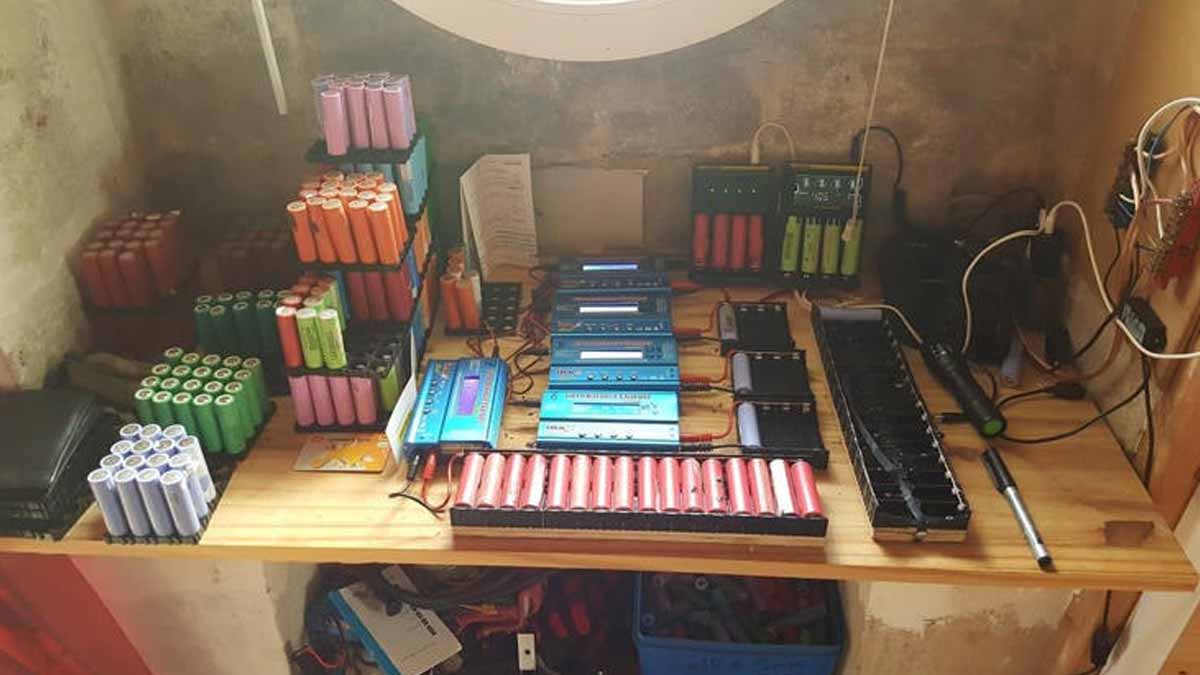An ordinary house runs on an unusual idea. Step by step, a patient tinkerer turned cast-off tech into steady home power. The result works every day and still keeps its secret sauce simple. In a world of rising bills and fragile grids, his off-grid setup shows how reuse, smart design, and calm care can deliver real energy independence without hype or drama.
How an off-grid idea turned waste into reliable power
In November 2016, a New Yorker known as Glubux began saving discarded laptop batteries. He did not use them whole. He opened each pack and rescued the lithium-ion cells inside. With care, he sorted and tested cells, then grouped the good ones. That slow work kept e-waste out of landfills and built a clean base for safe, long-lasting energy storage he could trust.
He then made custom battery blocks. Each block holds about 100 amp-hours, so it stores a lot of usable energy. He wired the blocks into a neat bank, using tidy runs and clear labels. Because he focused on order, he could scale up as his stash grew past 650. The design stayed modular, so a single block can be isolated, checked, or refreshed without taking down the house.
Uneven cells were the main risk. Old cells age at different rates and drift out of sync. To fix that, he balanced packs and, when needed, added extra cells to even the load. That choice reduced stress and heat, so safety improved. With balance, the bank delivers stable voltage and smooth output. Thanks to that, the whole system supports truly off-grid living day and night.
Inside the off-grid system: balancing, charging, and steady output
Safety never came by chance. Glubux planned for it. He handled lithium-ion cells with caution and watched for swelling, heat, or odd smells. Over the years, he reported zero fires and no swelling events. That clean record came from slow testing, regular checks, and gentle charge rates. Because he respected limits, his packs aged well and stayed calm under daily use.
Solar panels lift the project from clever to complete. He installed 24 panels, each rated at 440 watts. During the day, they feed the battery bank and top it off. When clouds roll in, the bank still has depth. At night, the stored energy runs lights, appliances, and devices without a flicker. The panels reduce bills to zero and, more importantly, push grid dependence close to none.
Reliability follows from routine. He watches discharge curves, notes odd cells, and keeps connections tight. As parts improved, he upgraded calmly, not all at once. A better wire here, a sturdier bus bar there. Those small moves prevent weak points. Because maintenance stays simple, the system avoids downtime. It remains off-grid even when storms cut power for neighbors.
A decade of results: resilience, savings, and less waste
Time is the honest test. Since 2016, the setup has run continuously in Farmingdale, New York. He has not replaced a single battery block. The pack, built from rescued cells, keeps holding charge. The home runs, seasons change, and the bank keeps cycling. That proves that second-life lithium-ion cells can work well when sorted, balanced, and treated with respect.
The social win matters too. Every salvaged cell is one less piece of e-waste. Old laptops no longer end in a drawer or dumpster. They power lights and heat instead. Because the system uses what others throw away, it fits the circular economy. It turns waste into value. At the same time, it cuts carbon because solar panels recharge the bank without fuel, smoke, or noise.
There is a lesson for anyone who wants energy independence. Start small, test often, and document everything. Use clear labels and simple layouts. Balance packs and keep airflow open. Add capacity in steps. Track state of charge and temperature trends. With patience, the path to off-grid resilience is not magic. It is method, care, and steady attention to detail.
Why these numbers and choices point to a different energy path
The details anchor the story. He began in November 2016 and still runs today. The battery blocks sit around 100 amp-hours each, so capacity scales cleanly. The solar array counts 24 panels at 440 watts each, which means robust charging even on short winter days. Careful pack balancing fixed uneven discharge. No fires, no swelling, no safety incidents have occurred over the years.
As the bank grew past 650 reclaimed packs, modular design kept the system easy to service. When a string drifted, he added cells or rebalanced it. When hardware improved, he upgraded wiring and bus work in place. Because he never rushed, reliability increased. The system now supplies a steady flow day and night, and it rides through clouds and outages without drama.
The project shows what focused DIY can achieve without exotic parts. It saves money, reduces e-waste, and builds confidence. It also proves that home energy can be personal, calm, and clean. With thoughtful planning, patience, and safe handling, regular people can reshape how they power their lives. Done right, the result stays off-grid, renewable, and remarkably dependable.
What this long run says about independence and everyday choices
This story is simple and strong. With salvaged cells, balanced packs, and a right-sized solar array, one home found control and calm. The approach cuts bills, waste, and stress while it builds resilience. Because the method scales, others can adapt it to their needs. As the seasons keep turning, off-grid power looks less like a gamble and more like common sense.
